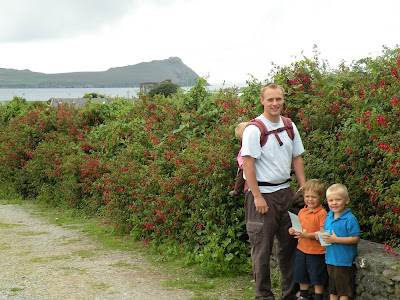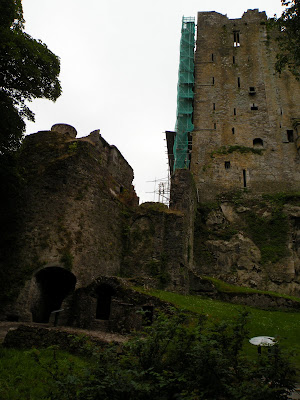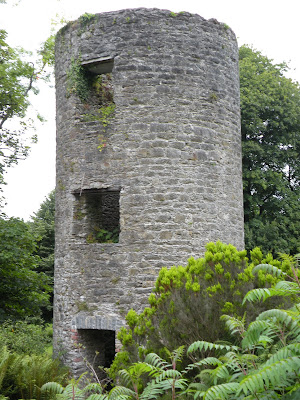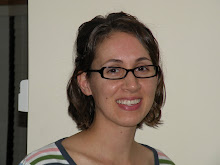 We decided to go down south to see the region the tour book calls "Cork & Kerry" - the two counties that make up this area. I marked our route in purple on the map. According to Eyewitness Travel: Ireland,
We decided to go down south to see the region the tour book calls "Cork & Kerry" - the two counties that make up this area. I marked our route in purple on the map. According to Eyewitness Travel: Ireland,Magnificent scenery has attracted visitors to this region since Victorian times. Rocky headlands jut out into the Atlantic and colourful fishing villages nestle in the shelter of the bays. County Kerry offers dramatic landscapes and a wealth of prehistoric and early Christian sites, whereas County Cork's gentle charm has enticed many a casual visitor into becoming a permanent resident.
Most of my pictures show the scenery from a moving car - we spent about 14 out of 17 hours driving! It was a misty day for the most part, but such is August in Ireland. Our summer here is over and it feels like a MN fall.
We drove through the village of Adare,
 "billed as Ireland's prettiest village, though cynics call it the prettiest 'English' village since its manicured perfection is at odds with normal notions of national beauty." The beauty would be more apparent if you could see the front garden of each house hidden behind the stone fences. I just took a few pictures as we drove through.
"billed as Ireland's prettiest village, though cynics call it the prettiest 'English' village since its manicured perfection is at odds with normal notions of national beauty." The beauty would be more apparent if you could see the front garden of each house hidden behind the stone fences. I just took a few pictures as we drove through.


Down into County Kerry




Starting out from Tralee onto the Dingle Peninsula




 The roads are lined with overgrown fuschia hedges. In some places, there is a ridge from sideview mirrors cutting through the hedge.
The roads are lined with overgrown fuschia hedges. In some places, there is a ridge from sideview mirrors cutting through the hedge.Aaron's reply was a little baffling because he didn't seem to be joking,
"Maybe they're dead swans..or maybe stars that fell down...or maybe pieces of cloud."
Did we just get to Ireland yesterday?!
Have we not seen like a million sheep this year?!
Have we not seen like a million sheep this year?!







Dingle
"A once remote Irish-speaking town is today a thriving fishing port and an increasingly popular tourist centre. The harbour is home to Dingle's biggest star: Fungie, the dolphin, who has been a permanent resident since 1983 and can be visited by boat or on swimming trips."
"A once remote Irish-speaking town is today a thriving fishing port and an increasingly popular tourist centre. The harbour is home to Dingle's biggest star: Fungie, the dolphin, who has been a permanent resident since 1983 and can be visited by boat or on swimming trips."





 Some of my favorite scenery was the color streaming past us as we drove along the narrow roads.
Some of my favorite scenery was the color streaming past us as we drove along the narrow roads. 

We stopped to see the Gallarus Oratory
"Shaped like an upturned boat, this miniature church overlooks the harbour at Ard na Caithne. Gallarus was built some time between the 6th and 9th centuries and is the best preserved early Christian church in Ireland. It represents the apogee of dry-stone (no mortar) corbelling, using techniques first developed by Stone-age tomb-makers. The stones were laid at slight angle, lower on the outside than the inside, allowing water to run off."




 no mortar
no mortar
 "Mommy, I got these for you!"
"Mommy, I got these for you!" Clogher Head
Clogher Head Way off in the distance, our first view of The Skelligs (more on them later).
Way off in the distance, our first view of The Skelligs (more on them later).Starting out from Killorglin onto The Ring of Kerry

 "This long-estblished route around the Iveragh Peninsula is always referred to as the Ring of Kerry. Allow a day to see its captivating mountain and coastal scenery, dotted with slate-roofed fishing villages." We had allowed ourselves 4 hours so we took it all in through the car windows.
"This long-estblished route around the Iveragh Peninsula is always referred to as the Ring of Kerry. Allow a day to see its captivating mountain and coastal scenery, dotted with slate-roofed fishing villages." We had allowed ourselves 4 hours so we took it all in through the car windows.
 Now, much closer to The Skelligs - Little Skellig on the left, and Skellig Michael on the right.
Now, much closer to The Skelligs - Little Skellig on the left, and Skellig Michael on the right. Skellig Michael, also known as Great Skellig, is a United Nations World Heritage Site.
Skellig Michael, also known as Great Skellig, is a United Nations World Heritage Site. Really? - A big rock?, you ask. But, there's more here than meets the eye.
"This inhospitable rock rising out of the Atlantic covers an area of 44 acres. Perched on a ledge almost 714ft above sea level and reached by an amazing 1,000-year-old stairway is an isolated early Christian monastery. Monks settled for solitude on Skellig Michael during the 6th century, building a cluster of six corbelled beehive cells and two boat-shaped oratories. These dry-stone structures (no mortar) are still standing, despite being raked by storms over the centuries. The monks were totally self-sufficient, trading eggs, feathers and seal meat with passing boats in return for cereals, tools and animal skins. The skins were needed to produce the vellum on which the monks copied their religious manuscripts. They remained on this bleak island until the 12th century, when they retreated to the Augustinian priory at Ballinskelligs on the mainland."
If you'd like to see a few pictures of the monestary (which one could visit, until recently), click here.








 Ballinskelligs Beach
Ballinskelligs Beach

We drove East into County Cork and on to Blarney Castle
 "Visitors from all over the world flock to this ruined castle to see the Blarney Stone. Kissing the stone is a long-standing tradition, intended to confer a magical eloquence. It is set in the wall below the castle battlements and, in order to kiss it, one is grasped by the feet and suspended backwards under the parapet."
"Visitors from all over the world flock to this ruined castle to see the Blarney Stone. Kissing the stone is a long-standing tradition, intended to confer a magical eloquence. It is set in the wall below the castle battlements and, in order to kiss it, one is grasped by the feet and suspended backwards under the parapet."I felt that, as long as we were in this area of Ireland, I should kiss the Blarney Stone. We got to the Castle, having driven clear across the south part of the country, just as they closed the entrance. I was not giving up without a fight. I snuck in the gift shop as some visitors were exiting, went up to the back of the ticket counter, explained to the lady that I'd come all the way from Galway today, and asked if I could possibly get in (they close the gate half hour before the castle closes, so I wasn't asking anyone to work late). She probably didn't want to deal with a crazy tourist, so she said to go ahead, but she couldn't promise the castle would still be open for kissing. She didn't even let me pay. So, I ran through the park to get to the castle...
 ...snapping this picture on the way so I could read later what exactly I was so intent on not missing.
...snapping this picture on the way so I could read later what exactly I was so intent on not missing. Blarney Castle, built in 1446 by Cormac MacCarthy, is the third structure to be built on this site. The MacCarthys remain one of the most ancient clans of Ireland, tracing their ancestry back to its earliest days. St Patrick himself converted one ancestor to Christianity. They were great warriors and were recognized by all as Kings of Munster [a province] - or almost all, if we are to include the English... Besieged at least four times, and taken once by Cromwell's army, the MacCarthys held onto their great fortress until forced to leave in the years following the Battle of the Boyne of 1690.
Blarney Castle, built in 1446 by Cormac MacCarthy, is the third structure to be built on this site. The MacCarthys remain one of the most ancient clans of Ireland, tracing their ancestry back to its earliest days. St Patrick himself converted one ancestor to Christianity. They were great warriors and were recognized by all as Kings of Munster [a province] - or almost all, if we are to include the English... Besieged at least four times, and taken once by Cromwell's army, the MacCarthys held onto their great fortress until forced to leave in the years following the Battle of the Boyne of 1690. Queen Elizabeth I is credited with introducing the word 'blarney' to the English language. Her emissary, Sir George Carew, was charged with persuading the MacCarthy chieftain to abandon his ancient rights and accept the authority of the English throne. Every time he tried, he was met with long and eloquent protestations of loyalty and honeyed flattery of the Queen - but also with no agreement. In frustration, Elizabeth exclaimed, "This is all Blarney! What he says he never means!" And a new word was born.
 For over 200 years, world statesmen, literary giants, and legends of the silver screen have joined the millions of pilgrims climbing the steps to kiss the Blarney Stone and gain the gift of eloquence. Its powers are unquestioned [except by me] but its story still creates debate.
For over 200 years, world statesmen, literary giants, and legends of the silver screen have joined the millions of pilgrims climbing the steps to kiss the Blarney Stone and gain the gift of eloquence. Its powers are unquestioned [except by me] but its story still creates debate.Some say it was Jacob's pillow, brought to Ireland by the prophet Jeremiah. [doubtful] Here it became the Lia Fail or 'Fatal Stone', used as an oracular throne of Irish kings - a kind of Harry Potter-like 'sorting hat' for kings. [I haven't read or seen Harry Potter so I don't even know what this means.] Legend says it was then removed to mainland Scotland, where it served as the prophetic power of royal succession, the Stone of Destiny. When Cormac MacCarthy, King of Munster, sent four thousand men to support Robert the Bruce in his defeat of the English at Bannockburn in 1314, the Stone was split and half was sent to Blarney.
All this useful information is from the plaque I took the picture of and read later.
So up 127 steps I ran to the top of the Castle...
 I made it. That's it - the Blarney Stone - wet with all the kisses. I did it - laid on my back, stretched over the edge, hung partway upsidedown, and kissed it.
I made it. That's it - the Blarney Stone - wet with all the kisses. I did it - laid on my back, stretched over the edge, hung partway upsidedown, and kissed it. It has not imparted any eloquence of speech to me...maybe the effects are gradual. At any rate, I can say, 'I've kissed the Blarney Stone.'

 I took one last look up and watched the last visitors of the day kiss it.
I took one last look up and watched the last visitors of the day kiss it.
 There are bars to catch you lest the attendant drop you and you slide, headfirst, over the edge.
There are bars to catch you lest the attendant drop you and you slide, headfirst, over the edge.
Moving on, we drove through the city of Cork.
 Cobh (pronounced cove) is a small town with a big story.
Cobh (pronounced cove) is a small town with a big story.
"Following a visit by Queen Victoria in 1849, Cobh was renamed Queenstown but reverted to its original name in 1921. The town has one of the world's largest natural harbours, hence its rise to prominence as a naval base in the 18th century. It was also a major port for merchant ships and the main port from which Irish emigrants left for America. Cobh was also a port of call for luxury passenger liners. In 1838, the Sirius made the first transatlantic crossing under steam power from here. Cobh was also the last stop for the Titanic, before its doomed Atlantic crossing in 1912. Three years later, the Lusitania was torpedoed and sunk by a German submarine just off Kinsale, southwest of Cobh."


 The entrance to a restaurant on the harbor.
The entrance to a restaurant on the harbor.
 I was trying to imagine watching the Titanic sail away...or being one of the 2.5 million Irish emigrants who left from this port, never to see my home again...or seeing the fishermen return who had rescued whom they could from the sinking Lusitania- 193 of the deceased they buried in their own church cemetery.
I was trying to imagine watching the Titanic sail away...or being one of the 2.5 million Irish emigrants who left from this port, never to see my home again...or seeing the fishermen return who had rescued whom they could from the sinking Lusitania- 193 of the deceased they buried in their own church cemetery.
 The Lusitania Memorial
The Lusitania Memorial
I just spent an hour reading about the sinking of the Lusitania - so many pieces of the story I had never learned. One entry on the list of notable passengers caught my attention: Sportsman, millionaire, member of the Vanderbilt family, Alfred Gwynne Vanderbilt (died) - last seen fastening a life vest onto a woman holding a baby. Among the dead were almost a hundred children.
 And this is Annie with her two little brothers...
And this is Annie with her two little brothers...
Annie Moore was born in 1877 in Cork City. The plaque under the statue reads:

 I took one last look up and watched the last visitors of the day kiss it.
I took one last look up and watched the last visitors of the day kiss it. There are bars to catch you lest the attendant drop you and you slide, headfirst, over the edge.
There are bars to catch you lest the attendant drop you and you slide, headfirst, over the edge.Moving on, we drove through the city of Cork.
We drove to the nearby town of Cobh, formerly called Queenstown
 Cobh (pronounced cove) is a small town with a big story.
Cobh (pronounced cove) is a small town with a big story."Following a visit by Queen Victoria in 1849, Cobh was renamed Queenstown but reverted to its original name in 1921. The town has one of the world's largest natural harbours, hence its rise to prominence as a naval base in the 18th century. It was also a major port for merchant ships and the main port from which Irish emigrants left for America. Cobh was also a port of call for luxury passenger liners. In 1838, the Sirius made the first transatlantic crossing under steam power from here. Cobh was also the last stop for the Titanic, before its doomed Atlantic crossing in 1912. Three years later, the Lusitania was torpedoed and sunk by a German submarine just off Kinsale, southwest of Cobh."


 The entrance to a restaurant on the harbor.
The entrance to a restaurant on the harbor. I was trying to imagine watching the Titanic sail away...or being one of the 2.5 million Irish emigrants who left from this port, never to see my home again...or seeing the fishermen return who had rescued whom they could from the sinking Lusitania- 193 of the deceased they buried in their own church cemetery.
I was trying to imagine watching the Titanic sail away...or being one of the 2.5 million Irish emigrants who left from this port, never to see my home again...or seeing the fishermen return who had rescued whom they could from the sinking Lusitania- 193 of the deceased they buried in their own church cemetery. Titanic's Last Anchorage
On April 11, 1912, the streets of Cobh, then called Queenstown, bustled with street vendors hawking their wares. Shops held special sales for the throng of tourists who had come to town, while hotels, restraunts, and pubs were filled to capacity. The entire town was ready for arrival of a brand new ship, the Titanic, hailed as the world's largest and most luxurious ocean liner. The monster ship glided into Cork Harbor, anchoring shortly before noon. Porters scrambled to get trunks and suitcases transferred from the local hotels to the waiting tenders for transport to the Titanic. The excitement was accompanied by the local pipe band, which played lively tunes that seemed to add to the city's festive mood. Meanwhile, reporters and photographers from all over the country were on board the grand ship. Members of the media were given tours and allowed to take pictures. These would be the last pictures taken of the floating palace. That afternoon, the Titanic pulled up her anchor and steamed towards the Atlantic Ocean. Nearly a week later, word reached Cobh about Titanic's tragic sinking. Family members who had said good-bye to loved ones boarding the ship just days earlier streamed back into the seaside town, as if that would somehow make the impending news of the passengers' fate easier. When the news arrived with the names of the dead, grief swept through town. A memorial service for the victims was held at St Colman's Cathedral. Although not everyone who boarded at Cobh was Irish, the loss was felt all over the country, especially at Cobh. - Colleen Fleidner
Almost exactly three years later - in May of 1915 - 1195 people perished when the Lusitania was torpedoed by a German submarine off the Irish coast on its way to Cork Harbor. It was a beautiful spring day and picnickers on the promontory point known as the Old Head of Kinsale watched the magnificent ship steaming along the coast of Cork. Suddenly, there was a huge explosion. The mighty ship lurched. A moment later, fiery smoke belched into the sky. There was a second explosion, and the ship quickly listed. The small audience that was perched on the cliff watched the horror unfolding before disbelieving eyes. Eighteen minutes after the first explosion, the Lusitania slid beneath the cobalt blue water. Word quickly spread to villages along the coast. Every available boat, dory, and dingy was launched in an effort to rescue survivors. Even though it was spring, the deep water was icy cold. Hundreds who had escaped the explosion and fire died of hypothermia. The lucky few who survived numbered 764 men, women, and children. Victims of the tragedy, both dead and alive, were taken to Cobh. Bodies were lined up along the waterfront until they could be identified. The hospital was overwhelmed, as were the hotels in both Cobh and nearby towns. Cobh's resilient residents volunteered to take the overflow of passengers into their homes as long as necessary. Hundreds of corpses were never claimed. Massive communal graves were dug at the Old Church Cemetery on the edge of town, marked only with a stone bearing a plaque reading, "Lusitania, May 1915." In some cases, individual plots were purchased by next of kin. The survivors who weren't injured badly sat together in the pews at St. Colman's for the special memorial service honoring those who had perished, an event that mirrored the observance held for the Titanic in the same place three years before. - Colleen Fliedner
 The Lusitania Memorial
The Lusitania MemorialI just spent an hour reading about the sinking of the Lusitania - so many pieces of the story I had never learned. One entry on the list of notable passengers caught my attention: Sportsman, millionaire, member of the Vanderbilt family, Alfred Gwynne Vanderbilt (died) - last seen fastening a life vest onto a woman holding a baby. Among the dead were almost a hundred children.
 And this is Annie with her two little brothers...
And this is Annie with her two little brothers...Annie Moore was born in 1877 in Cork City. The plaque under the statue reads:
Annie Moore and her brothers Anthony and Philip embarked from this town on 20 December 1891 on the S.S. Nevada. Annie was the first person to be admitted to the United States of America through the new immigration centre at Ellis Island, New York on 1 January, 1892 [her 15th birthday]. This sculpture...is dedicated to all who emigrated from Ireland.
A similar statue stands on Ellis Island.
Annie lived with her parents for a few years at 32 Monroe Street in Manhattan before marrying in 1895. The couple had at least 11 children. Five survived to adulthood, three of whom had children. Annie Moore died of heart failure on 6 December 1924 at the age of 47, but her descendants live on.





















No comments:
Post a Comment